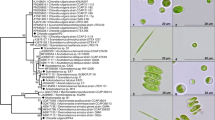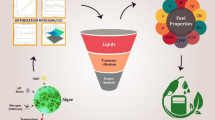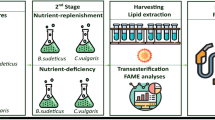Abstract
Lipid-accumulating microalgae are an emerging feedstock for production of liquid biofuel because of their high biomass and lipid productivity. The potential of the green microalgae, Chlorolobion sp. (BIOTECH 4031) and Chlorella sp. (BIOTECH 4026), for biodiesel production was evaluated by analyzing the effect of nitrogen starvation (0.375–1.500 g L−1 NaNO3) on growth response, oil yield, and fatty acid methyl ester (FAME) profiles of the two algal strains. Maximum biomass yields for Chlorolobion sp. and Chlorella sp. were obtained after 20 days of cultivation using the control medium (1.5 g L−1 NaNO3) with 0.873 g L−1 and 0.757 g L−1, respectively. An increasing trend in the total lipid yield was observed under a nitrogen-starved culture condition (0.375 g L−1 NaNO3). When the amount of nitrate was limited, the mean oil contents of Chlorolobion sp. and Chlorella sp. were 31.61 and 28.77% with lipid productivity of 227.84 and 151.14 mg L−1 day−1, respectively. Nitrogen starvation caused an increase in the lipid yield and a decrease in biomass production of the two microalgae. The FAME profile of the obtained algal biodiesel shows a high concentration of saturated fatty acid (SAFA) and monounsaturated fatty acid (MUFA) methyl esters which are desirable for biodiesel production. The fuel properties of biodiesel from the two microalgae were predicted based on the molecular properties of fatty acid methyl esters using empirical equations showing that the biodiesel properties of the two microalgae satisfied the set specifications of biodiesel standards EN 14214 (European) and ASTM D6751 (American). The quality properties of biodiesel obtained for Chlorolobion sp. were low density (0.89 g cm−3), low kinematic viscosity (2.79 mm2 s−1), cetane number (65.17), and oxidation stability (8.93 h). On the other hand, Chlorella sp. has low density (0.88 g cm−3), low kinematic viscosity (2.78 mm2 s−1), good cetane number (68.79), and oxidation stability (10.44 h). Hence, Chlorolobion sp. (BIOTECH 4031) and Chlorella sp. (BIOTECH 4026) have potential as raw material for production of biodiesel with superior fuel quality.


Similar content being viewed by others
References
Aboal M, González-Silvera D, Roldán M, Hernández-Mariné M, López-Jiménez JA, Whitton BA (2014) The freshwater alga Chroothece richteriana (Rhodophyta) as a potential source of lipids. Food Chem 162:143–148
Al-Iwyzy SH, Yusaf T, Al-Juboori A (2014) Biofuels from the fresh water microalgae Chlorella vulgaris (FWM-CV) for diesel engines. Energies 7:1829–1851
Anand J, Arumugam M (2015) Enhanced lipid accumulation and biomass yield of Scenedesmus quadricauda under nitrogen starved condition. Bioresour Technol 188:190–194
Arguelles EDLR, Laurena AC, Monsalud RG, Martinez-Goss MR (2018) Fatty acid profile and fuel-derived physico-chemical properties of biodiesel obtained from an indigenous green microalga, Desmodesmus sp. (I-AU1), as potential source of renewable lipid and high quality biodiesel. J Appl Phycol 30:411–419
Arguelles EDLR, Laurena AC, Monsalud RG, Martinez-Goss MR (2019) High lipid and protein-producing epilithic microalga, Desmodesmus sp. (U-AU2): a promising alternative feedstock for biodiesel and animal feed production. Philipp J Crop Sci 44:13–23
Arias-Peñaranda MT, Cristiani-Urbina E, Montes-Horcasitas C, Esparza-García F, Torzillo G, Cañizares-Villanueva RO (2013) Scenedesmus incrassatulus CLHE-Si01: a potential source of renewable lipid for high quality biodiesel production. Bioresour Technol 140:158–164
ASTM (2015) ASTM D6751-15ce1, standard specification for biodiesel fuel blend stock (B100) for middle distillate fuels. ASTM International, West Conshohocken www.astm.org
Borowitzka MA (1999) Commercial production of microalgae: ponds, tanks, tubes and fermenters. J Biotechnol 70:313–321
Breuer G, Lamers PP, Martens DE, Draaisma RB, Wijffels RH (2012) The impact of nitrogen starvation on the dynamics of triacylglycerol accumulation in nine microalgae strains. Bioresour Technol 124:217–226
Choi GG, Kim BH, Ahn CY, Oh HM (2011) Effect of nitrogen limitation on oleic acid biosynthesis in Botryococcus braunii. J Appl Phycol 23:1031–1037
Cohen Z (1999) Porphyridium cruentum. In: Cohen Z (ed) Chemicals from microalgae. Taylor & Francis, London, pp 1–24
Enamala MK, Enamala S, Chavali M, Donepudi J, Yadavalli R, Kolapalli B, Aradhyula TV, Velpuri J, Kuppam C (2018) Production of biofuels from microalgae - a review on cultivation, harvesting, lipid extraction, and numerous applications of microalgae. Renew Sust Energ Rev 94:49–68
European Committee for Standardization (2009) Automotive fuels—fatty acid methyl esters (FAME) for diesel engines—requirement methods; EN 14214:2008. CEN, Brussels
Gao C, Zhai Y, Ding Y, Wu Q (2010) Application of sweet sorghum for biodiesel production by heterotrophic microalga Chlorella protothecoides. Appl Energy 87:756–761
Gopinath A, Sairam K, Velraj R, Kumaresan G (2014) Effects of the properties and the structural configurations of fatty acid methyl esters on the properties of biodiesel fuel: a review. Proc Inst Mech Eng D 229:357–390
Griffiths MJ, Harrison STL (2009) Lipid productivity as a key characteristic for choosing algal species for biodiesel production. J Appl Phycol 21:493–507
Guillard RRL (1973) Division rates. In: Stein JR (ed) Handbook of phycological methods, vol 1. Cambridge University Press, Cambridge, pp 289–312
Guillard RR, Sieracki MS (2005) Counting cells in cultures with the light microscope. In: Andersen RA (ed) Algal culturing techniques. Elsevier Academic Press, London, pp 239–252
Ho S-H, Chen W-M, Chang J-S (2010) Scenedesmus obliquus CNW-N as a potential candidate for CO2 mitigation and biodiesel production. Bioresour Technol 101:8725–8730
Hoekman SK, Broch A, Robbins C, Ceniceros E, Natarajan M (2012) Review of biodiesel composition, properties, and specifications. Renew Sust Energ Rev 16:143–169
Huerlimann R, de Nys R, Heimann K (2010) Growth, lipid content, productivity, and fatty acid composition of tropical microalgae for scale-up production. Biotechnol Bioeng 107:245–257
Illman AM, Scragg AH, Shales SW (2000) Increase in Chlorella strains calorific values when grown in low nitrogen medium. Enzym Microb Technol 27:631–635
Islam MA, Magnusson M, Brown RJ, Ayoko GA, Nabi MN, Heimann K (2013) Microalgal species selection for biodiesel production based on fuel properties derived from fatty acid profiles. Energies 6:5676–5702
Ito T, Tanaka M, Shinkawa H, Nakada T, Ano Y, Kurano N, Soga T, Tomita M (2013) Metabolic and morphological changes of an oil accumulating trebouxiophycean alga in nitrogen-deficient conditions. Metabolomics 9:178–187
Knothe G (2005) Dependence of biodiesel fuel properties on the structure of fatty acid alkyl esters. Fuel Process Technol 86:1059–1070
Knothe G (2009) Improving biodiesel fuel properties by modifying fatty ester composition. Energy Environ Sci 2:759–766
Knothe G (2013) Production and properties of biodiesel from algal oils. In: Borowitzka MA, Moheimani NR (eds) Algae for biofuels and energy. Springer, Dordrecht, pp 207–221
Li YQ, Horsman M, Wang B, Wu N, Lan CQ (2008) Effects of nitrogen sources on cell growth and lipid accumulation of green alga Neochloris oleoabundans. Appl Microbiol Biotechnol 81:629–636
Mandotra SK, Kumar P, Suseela MR, Ramteke PW (2014) Fresh water green microalga Scenedesmus abundans: a potential feedstock for high quality biodiesel production. Bioresour Technol 156:42–47
Mostafa SSM, El-Gendy NS (2017) Evaluation of fuel properties for microalgae Spirulina platensis bio-diesel and its blends with Egyptian petro-diesel. Arab J Chem 10:S2040–S2050
Musharraf SG, Ahmed MA, Zehra N, Kabir N, Choudhary MI, Rahman A (2012) Biodiesel production from microalgal isolates of southern Pakistan and quantification of FAMEs by GC-MS/MS analysis. Chem Cent J 6:149. https://doi.org/10.1186/1752-153X-6-149
Ördög V, Stirk WA, Bálint P, Staden JV, Lovász C (2012) Changes in lipid, protein and pigment concentrations in nitrogen-stressed Chlorella minutissima cultures. J Appl Phycol 24:907–914
Pancha I, Chokshi K, George B, Ghosh T, Paliwal C, Maurya R, Mishhra S (2014) Nitrogen stress triggered biochemical and morphological changes in the microalgae Scenedesmus sp. CCNM 1077. Bioresour Technol 156:146–154
Pruvost J, Vooren G, Gouic B, Mossion A, Legrand J (2011) Systematic investigation of biomass and lipid productivity by microalgae in photobioreactors for biodiesel application. Bioresour Technol 102:150–158
Ramírez-Verduzco LF, Rodríguez-Rodríguez JE, Jaramillo-Jacob ADR (2012) Predicting cetane number, kinematic viscosity, density and higher heating value of biodiesel from its fatty acidmethyl ester composition. Fuel 91:102–111
Sabu S, Bright-Singh LS, Joseph V (2017) Molecular identification and comparative evaluation of tropical marine microalgae for biodiesel production. Mar Biotechnol 19:328–344
Saxena P, Jawale S, Joshipura MH (2013) A review on prediction of properties of biodiesel and blends of biodiesel. Procedia Eng 51:395–402
Sharma KK, Schuhmann H, Schenk PM (2012) High lipid induction in microalgae for biodiesel production. Energies 5:1532–1553
Sinha SK, Gupta A, Bharalee R (2016) Production of biodiesel from freshwater microalgae and evaluation of fuel properties based on fatty acid methyl ester profile. Biofuels 7(1):69–78
Stanier RY, Kunizawa R, Mandel M, Cohen-Bazire G (1971) Purification and properties of unicellular blue green algae (order Chroococcales). Bacteriol Rev 35:171–205
Talebi AF, Tabatabaei M, Chisti Y (2014) Biodiesel analyzer: an user-friendly software for predicting the properties of prospective biodiesel. Biofuel Res J 2:55–57
Vello V, Phang SM, Chu W, Majid NA, Lim P, Loh S (2014) Lipid productivity and fatty acid composition-guided selection of Chlorella strains isolated from Malaysia for biodiesel production. J Appl Phycol 26:1399–1413
Xu H, Miao X, Wu Q (2006) High quality biodiesel production from a microalga Chlorella protothecoides by heterotrophic growth in fermenters. J Biotechnol 126:499–507
Yang L, Chen J, Qin S, Zeng M, Jiang Y, Hu L, Xiao P, Hao W, Hu Z, Lei A, Wang J (2018) Growth and lipid accumulation by different nutrients in the microalga Chlamydomonas reinhardtii. Biotechnol Biofuels 11:40
Zhang Y, Wu H, Yuan C, Li T, Li A (2019) Growth, biochemical composition, and photosynthetic performance of Scenedesmus acuminatus during nitrogen starvation and resupply. J Appl Phycol 31:2797–2809
Acknowledgments
The senior author is thankful for the support of the Philippine National Collection of Microorganisms, National Institute of Molecular Biology and Biotechnology (BIOTECH), University of the Philippines Los Baños. Furthermore, the senior author greatly appreciates the anonymous reviewers for their significant and useful suggestions and comments. The senior author also is grateful to Ms. Allysa Mae P. Gargarino and Mr. Kendrick B. Nortez for the assistance rendered for the statistical analysis needed in the manuscript preparation.
Author information
Authors and Affiliations
Corresponding author
Additional information
Publisher’s note
Springer Nature remains neutral with regard to jurisdictional claims in published maps and institutional affiliations.
Rights and permissions
About this article
Cite this article
Arguelles, E.D., Martinez-Goss, M.R. Lipid accumulation and profiling in microalgae Chlorolobion sp. (BIOTECH 4031) and Chlorella sp. (BIOTECH 4026) during nitrogen starvation for biodiesel production. J Appl Phycol 33, 1–11 (2021). https://doi.org/10.1007/s10811-020-02126-z
Received:
Revised:
Accepted:
Published:
Issue Date:
DOI: https://doi.org/10.1007/s10811-020-02126-z




